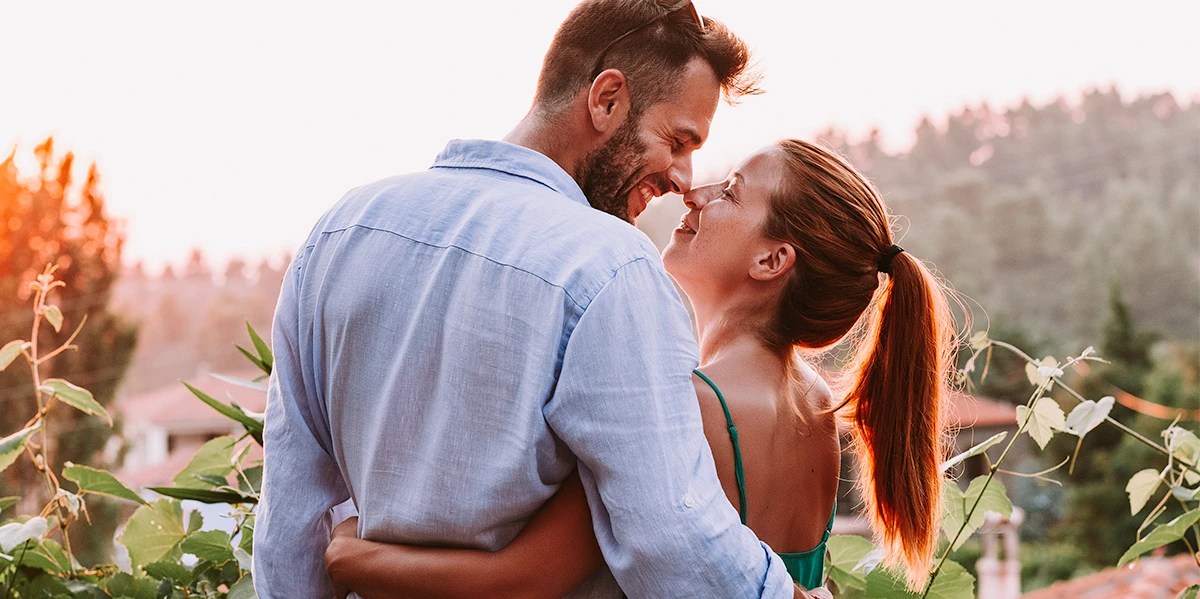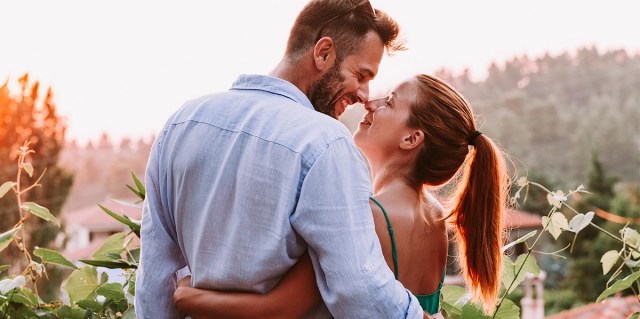
How His Body Reveals If He Actually Likes You (Or Just Tolerates You)
Make sure you notice how they act around you.
By The Good Men Project — Updated on Jun 02, 2023
Photo: Marjan Apostolovic / Shutterstock 
By Harris O’Malley
Being able to read body language is a powerful tool to have in your social toolbox. After all, meeting people can be intimidating at times. You want them to like you.
Sometimes you want them to like you like you. You don’t want to end up annoying them, creeping them out, or otherwise messing up meeting a potential new friend or partner. At the same time, you can’t read their minds to gauge how they’re feeling about you.
Being able to read their body language, on the other hand, gives you the insight you crave.
Now, despite what movies and TV will tell you, reading body language isn’t like doing a Sherlock scan on someone. You’re not going to be astounding people with your telepathic party tricks. But if you want to have a better sense of how someone feels or what they think about you, being able to read their body language will help you out.
To read body language accurately, make sure to get some context.
The first thing you need to do if you want to read someone’s body language is to have a sense of who they are.
One of the most common causes of misunderstandings is confusing body language signals with… well, life. People are individuals, which means that while there are commonalities, there aren’t any universal constants. One person’s body language sign of interest is another person’s “I never know what to do with my hands.”
For example, one of the most common signs of discomfort or disinterest is crossed arms. Crossing one’s arms is closed-off body language; they’re putting a barrier between you and them.
Except sometimes that’s just how they stand. Some people tuck their hands in their pockets. Others tuck them under their armpits. Similarly, someone who’s jittery or shifting their body weight around may be nervous, or they may have had three espressos and now they areabouttovibratethroughspaceandtimeohlookicanseetothecenteroftheuniverse. Some people may stand or sit in ways that might suggest certain interests…
…when in reality, it’s just their “thing”.
So before you try to parse what that hair flip or half-smile means, take time to observe them and get a feel for their baseline behavior. Are they giggly, touchy-feely people in general, or just with you? Are they closed-off and monosyllabic with everyone? Do they make a lot of hand gestures or keep them in their pockets?
Remember: one of the ways to help get a more effective feel for somebody’s body language is to follow the Rule of Four. Look for four body language signs or cues that are occurring either simultaneously or right on top of one another. A wink by itself could just be a nervous tic. A wink, a smile, a laugh, and opening up their body language, on the other hand, is a sign.
If there’s one area that dominates what our body language is saying, it’s our core. Our chest, abdomen, and waist are our most vulnerable areas and hold some of our most vital organs. We’re incredibly protective of our core for good reason, and so it becomes the center of a lot of the meaning in our body language.
We protect our vulnerable core when we’re nervous or scared. We hunch over, we turn away slightly, we cross our arms, we fold our arms across our body, or hold items in front of us. Somebody at the bookstore who’s nervous or intimidated, for example, may clutch their books to their chest or hold them out almost like a shield.
On the other hand, someone who’s feeling comfortable or confident is going to expose their core. We’re not worried that the other person is going to hurt us and so we’re willing to put ourselves in a position that potentially makes us vulnerable. We open up to people we like or are attracted to in particular because we’re hoping to be in especially vulnerable positions with them.
Watching someone’s core is an important means of reading their body language and determining how they’re feeling.
Our core also exposes our interests. Humans, as a species, are goal-oriented.
We point ourselves at things that interest us, whether it’s a person, a drink, or a way out. At the same time, we point ourselves away from things we dislike. When we see someone we don’t like coming towards us, we turn away from them.
It squeezes them out, protects our core, and keeps them from making eye contact and invoking the social contract that says “Now you must acknowledge me.” When we want to leave a conversation, we start twisting our torsos toward a potential exit.
When you want to know how somebody’s feeling, watch their core. The more it turns towards you, the more they like you and feel comfortable with you. The more they turn away or fold in, the less comfortable they are.
Follow the limbs.
Just as the torso gives away signs of interest and discomfort, so do our limbs. Our arms and legs play key — and occasionally surprisingly subtle — roles in our body language. Our arms, for example, give away much about how we feel in the moment. When we’re feeling nervous or tense, we tend to keep our arms close to our bodies. It ties into our instinctive desire to protect our core; keeping our arms close puts us in a better position to defend ourselves. When we feel insecure, we try to take up less space and pull inward to be less noticeable.
On the other hand, according to body language expert Joe Navarro, when we’re happy or excited, our arms tend to move away from our bodies. We make more exaggerated gestures and take up more space. The happier we are, the more we raise our arms in the air. There’s a reason why we throw our hands up at parties, sporting events, religious celebrations, and so on.
But as obvious as the arms can be, it’s our legs and feet that can tell the real tale about how somebody’s feeling.
Just as we show interest by where we angle our torsos, we also show interest with our legs. We point at the things we’re interested in with our feet. When we appreciate somebody’s company and want to spend time with them, we will angle our feet to point at them.
At the same time however, when we are wanting to go somewhere else — to go to the bar, to find someone else to talk to, or otherwise just get away — we’ll start to point our feet in that direction. Crossing legs, on the other hand, can be a sign of interest — especially when her knees or the dangling foot is pointing at you.
The eyes have it, and so does the face.
As much as you may be paying attention to their legs and torso… don’t forget that you need to keep track of their face.
It should come as no surprise that the face does most of our communication for us; communicating through facial expressions predates language after all. Infants will instinctively look to their parent’s faces for love, reassurance and to try to communicate. The face gives hundreds upon hundreds of little signals and cues about how someone feels or what they’re thinking.
For example, if you want to know whether someone likes you or just tolerates you, look into their eyes. The eyes are possibly the most expressive part of the human body. When it comes to communication, they’re almost certainly the most powerful; strong eye contact alone can create feelings of love and affection in strangers.
Most importantly, though, the eyes will tell you when someone is genuinely happy to see you. When someone gives you a genuine smile — also known as a Duchenne smile — it will activate the muscles around their eyes.
Their eyes will crinkle in the corners, their eyebrows will engage and lift slightly. A fake smile, on the other hand, will be all mouth. You can see the difference between real smiles and fake smiles in this online test if you want to practice looking for telltale clues.
But while we may put a lot of emphasis on the eyes, the mouth and jaw also give away significant hints of how we feel. When we’re stressed or uncomfortable, we hold tension in our jaws. Our lips will purse and get thinner and thinner; the tighter the lips, the more upset we are.
On the opposite end of the emotional spectrum, you can see signs of interest in a person’s nose. Yes. Their nose. When we get physically aroused, our nostrils flare; the better to increase our oxygen intake in preparation for fighting, fleeing, or f***ing. When the date is going very well and you see their nostrils starting to flare, that’s a strong signal that it may be time to go for the kiss.
Mimicry is the key. Are you getting the vibe that someone you’re flirting with is into you? Take a sip of your drink and see what they do.
One of the surest signs that somebody likes us is that they’ll start to mimic us. Humans are social animals; we rely on our “tribe” to survive, and so we prioritize our relationships with those people who are like us. When we like somebody and want them to like us back, we’ll often start to mimic them in order to give the “hey, I’m like you” signal.
For example, we’ll often adopt similar body language to the person we like. If they’re sitting with their arms held out in front of them, we’ll often unconsciously adopt a similar pose. If they put their weight on one side, then we’ll often unconsciously shift to match.
We may also make similar gestures as they do; if they take a sip from their drink, we will do likewise. If they’re very expressive with their hands, we’ll start to gesture more with ours. We may even find ourselves matching their speech patterns and cadences. If you’ve ever found yourself using similar turns of phrase as a friend or a partner, then you’ll have experienced this yourself. Some people (myself included) may even start to pick up the other person’s accent.
It can be intimidating trying to tell if someone likes you or not. But once you become conversant in the myriad little ways we give away our true feelings without meaning to, the more you’ll pick up on them without even trying.
Take the time to observe others and watch their body language; soon you’ll be reading other people’s true intentions like a master.
More for You:
Zodiac Signs That Are Terrible At Relationships (And Why)20 Little Things Women Do That Guys *Secretly* LoveThe Perfect Age To Get Married, According To Science5 Little Ways Men Wish They Could Be Loved — Every Single Day
Harris O’Malley is an internationally recognized blogger, writer, and dating coach who gives dating advice to all who need them.
Source: YourTango

